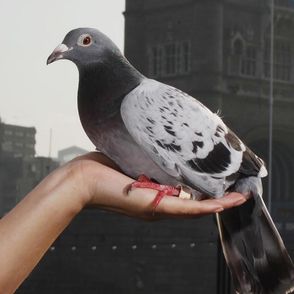Pigeon Bermuda Triangle mistery solved
Scientists have announced that the mystery of the “Bermuda Triangle” of the homing pigeon world may have been solved.
For years, scientists have been baffled as to why the usually excellent navigators get lost when released from a particular site in New York State.
But new research suggests the birds are using low frequency sounds to find their way around – and they cannot hear the rumble at this US location.
The study is published in the Journal of Experimental Biology.
The lead author of the paper, Dr. Jonathan Hagstrum, from the US Geological Survey, said that the birds were creating “acoustic maps” of their surroundings.
But some other researchers said the theory was controversial and there was much debate over how homing pigeons navigate so efficiently.
The puzzle of the vanishing pigeons began in the 1960s.
Professor Bill Keeton from Cornell University was trying to understand the birds’ astonishing ability to find their way home from places they have never previously visited.
He released birds throughout New York State, but was surprised to discover that whenever the pigeons were released at Jersey Hill, near Ithaca, they became disorientated and flew about aimlessly.
This happened again and again, apart from on one occasion on August 13, 1969, when the birds’ navigational prowess returned and they flew back to their loft.
Dr. Jonathan Hagstrum has now come up with an explanation.
He said: “The way birds navigate is that they use a compass and they use a map. The compass is usually the position of the Sun or the Earth’s magnetic field, but the map has been unknown for decades.
“I have found they are using sound as their map… and this will tell them where they are relative to their home.”

Scientists have announced that the mystery of the “Bermuda Triangle” of the homing pigeon world may have been solved
The pigeons, he said, use “infrasound”, which is an extremely low-frequency sound that is below the range of human hearing.
He explained: “The sound originates in the ocean. Waves in the deep ocean are interfering and they create sound in both the atmosphere and the Earth. You can pick this energy up anywhere on Earth, in the centre of a continent even.”
He believes that when the birds are at their unfamiliar release site, they listen for the signature of the infrasound signal from their home – and then use this to find their bearings.
However, infrasound can be affected by changes in the atmosphere.
Dr. Jonathan Hagstrum used temperature and wind records taken from the dates of the various experimental releases to calculate how the sound would have travelled from the pigeons’ base to Jersey Hill.
“The temperature structure and the wind structure of the atmosphere were such in upstate New York that the sound was bent up and over Jersey Hill,” he explained.
This meant the birds could not hear it and got lost – apart from the day that the birds found their way home.
He said: “On 13 August 1969, there was either a wind shear or temperature inversion in the troposphere that bent the sound back down so it arrived right back at Jersey Hill on that day, and that day alone.”
Dr. Jonathan Hagstrum thinks that disruptions of infrasound may also explain other homing pigeon puzzles, where large numbers of pigeons lose their way, such as a race in 1997 across the English channel where 60,000 birds veered off course.
He admitted his work was “controversial”, but said: “This doesn’t prove it by any stretch – but it puts out a new idea, which, as far as I’m concerned, is the best explanation of what pigeons are doing, because it explains what has been going on at Jersey Hill.”
Others have put forward different ideas for how pigeons find their way, suggesting that the birds use smell, visual clues or the Earth’s magnetic field, or even a combination of all of these.
[youtube Mbi6fFqkSDA]

